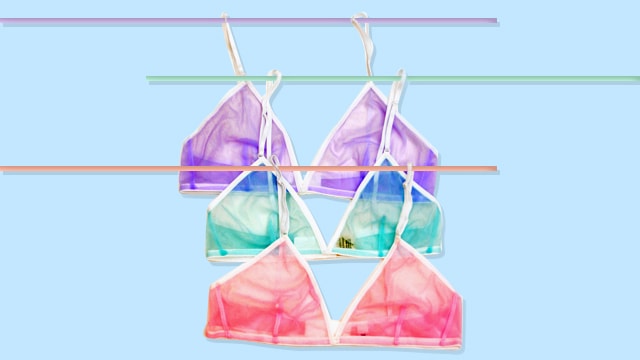With the changing time and evolving mindsets of women across the globe, intimate wear has evolved with the aesthetic as well as the body fits. Updating intimate wear isn’t simply about stocking up on aesthetics anymore… It’s as much about function as it is about fashion. The international market has seen greater emphasis on comfort without compromising on aesthetics, Indian exporters working in the category have pondered on this high call and are revolutionising the basic need intimate wear to an extraordinary level, with different techniques which clues on what the big trends are going to be next year.
Adding value to intimate wear is more challenging than ever. Women anywhere in the world and from any segment of society are interested in purchasing intimate apparel that not only covers, but shapes their bodies and also makes them look ‘desirable’. On one side is the basic fabric for greater comfort and fit, while on the other is the challenge of how to make the garment more ‘appealing’. Following indications from what is happening internationally, Indian exporters and fabric suppliers are doing their bit.
Performance plays fabrics
The idea of intimate wear for many of late has led to a focus shift from the standard fits, to extraordinary comfort and performance using fabrics that have special properties. Aspects like perfect support, caressing softness and cosy comfort are considered in compiling a range that makes the garment feel sensational to the wearer. Hence, big brands have shifted their focus on the same. A 31-year-old international award winning brand ‘Anita’ has come up with intimate maternity wear where the bras are designed in cotton that allows the skin to breathe, lowering the risk of infection and preventing discomfort and microbial activity. The liners are made from super absorbent hemp that wick and draw moisture away from your body.
Corroborating the emphasis on performance fabric, Anand Singh, Design & Development Manager at Arvind Lifestyle says, “Intimate wear fabrics, have lately been engineered to upgrade the value and comfort of the intimate wear and satiate the growing demand of performance fabrics for both intimate and active wear. Fabrics made with the blend of Modals, Viscose and Bamboo, are playing the most effective and efficient role as far as the performance is concerned. Bamboo has inherent anti-micro bacterial properties; its blending properties with others give perfect stretch to the fabric and fit to the body. The major R&D that is happening is in the yarn play and finishes. Similarly, we are also working on sustainable production, in order to reduce the carbon footprint. We have focused on finishes like ‘eco finish’ which is a bio mimicry concept to abate wicking. The other one is ‘eco wash’, which devoids the use of detergent on washing these fabrics; fabrics itself have self-detergent properties where the performance and sustainability goes hand-in-hand.”
Fabric permutation and combination
Comfort is that one most important element which defines intimate wear. A woman who wishes to look beautiful, also desires for an equally settled stretch, hand feel and comfort. With the permutations and combinations, international designers have made it possible for a woman to achieve the two equally at pinnacle. With the snowballing of comfort fit, Raj Kumar Agarwal, Partner, SVG Fashions Ltd. maintains that Spandex is that one basic tool which has given the perfect fit to the intimate wear. “Different fabrics with P&C techniques experimented on modals and spandex with satin, nylon and viscose fabrics have not only contributed in the comfort stretch but have also provided a very feathery smooth feel to the skin. Satin slip dresses and nighties which used to be loose and flouncy are now experimented on making them skin fit nightwear which can solve the purpose of daywear too; for example, satin and lace slip skin fit dresses with blends of spandex and lycra provide a dual advantage to the women,” shares Raj Kumar.
Digital reactive prints
Continuing the trends of prints, big labels like ‘Guess’ and ‘Topshop’ showcased a miscellany of vibrant and playful digital animal, floral and abstract prints on bras, panties and swimsuit collection for S/S ’17. On a practical note, printing speed has inhibited the success of digital printing for large production runs, and printing stretch fabrics, particularly wide-width, fine-gauge knits in polyamide and elastane for the intimate apparel and swimwear markets, has also proven a challenge. Depending on weight, printing on knitted fabrics runs slower, and the penetration of a single colour in large areas can result in ‘grin-through’ when the fabric is stretched.
Pranav Sachdeva, Director, Mercury views, “Because intimate apparel require less fabric, the flexibility of digital printing for smaller runs and quick turnarounds make the technology a viable option for knitted stretch fabrics.
We are using reactive prints on fabrics for the intimate wear segment, which gives a smooth finish and a softer hand feel. Reactive prints can use 100 prints on the same fabric without distorting the quality of print. The finish is produced by 19 chamber washers, which sustains the quality and feel of the fabric, unlike pigments.”
Lacing up for sensuality
GSQ’s ethereal and subtle laces from the last collection were replaced by interplay of details focused on forms, cut-outs, non-standard mix and matches of concepts. As a whole, it is very feminine, yet quite provocative at the same time. Laces on hems creating appliqué structures on the intimate wear made the product even more alluring and sensual. The new lingerie collection for the coming season will witness a combination of laces, see-through details, microfiber and elastic. With laces and fabric manipulation gaining momentum in the market, Abhay Chapiya from Kamal Exports avers that intimate wear has moved to another level. “Intimate wear has never looked that beautiful until laces were experimented on them. Different types of laces like Russian, textronic and jacquardtronic for high-end designs provide a classy sensual look to the garments. Women have accepted the fact that spending on intimate wear is one best thing to do so, and so are ready to spend on such high-quality fabric manipulations,” he concludes.








